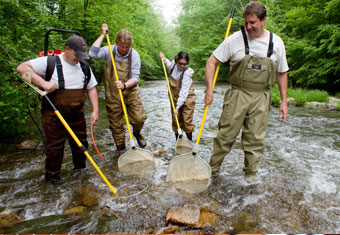

Abstract
The Appalachian region is home to nearly half of the United States’ salamander species, including the hellbender (Cryptobranchus alleganiensis), but populations throughout this area are mysteriously vanishing. Climate change may be contributing to the current decline of amphibians (i.e., frogs and salamanders) and will likely threaten Appalachian salamanders because they are adapted to cool mountain habitats. This project will investigate the biological effects of climate change on hellbenders, with the hypotheses that 1) realistic patterns of temperature change will have negative consequences on metabolism (energy production) and immunity (disease resistance) in captive hellbenders, 2) these immune and metabolic changes will be associated with increased biological ‘stress’ and 3) temperature-related stress can worsen the effects of other environmental pressures in the wild.
We will study a captive population of hellbenders at the Smithsonian Conservation Biology Institute (Washington, D.C.) to determine the biological effects of three types of temperature change: short-term variation, seasonal changes and overall warming. Specifically, we will look for temperature-related changes in two main parts of the immune system: ‘attack’ proteins and ‘antibiotic’-producing cells (i.e., complement proteins and T-lymphocytes). Oxygen intake of hellbenders will be measured as an indicator of metabolism. We will link immune and metabolic findings to corresponding changes in the number and type of immune cells present in the blood, which provides an indication of biological ‘stress’. Field data collected along a 600-mile stretch of the Appalachian Mountains will be combined with results of the captive study to determine if temperature can worsen the effects of poor water quality in hellbender habitat. These studies will help determine the ability of hellbenders to adapt to climate change and may provide insight into the mysterious declines of Appalachian amphibian species. This knowledge is critical to developing effective conservation strategies to ensure the survival of American salamanders in a changing environment.
